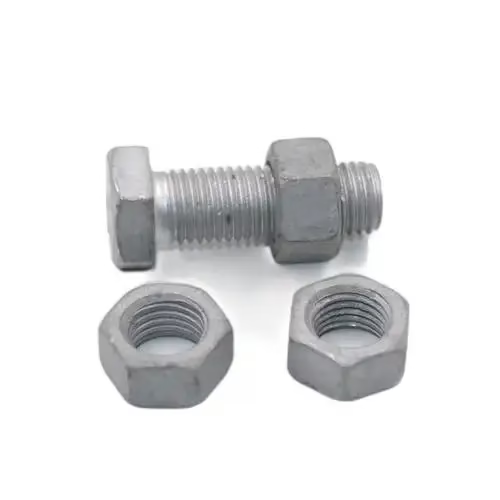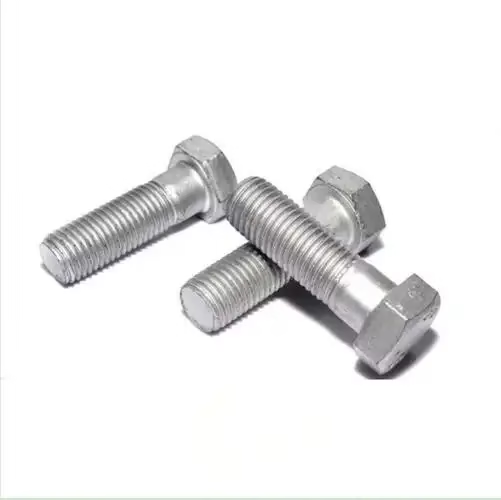For our clients in world-class maritime, offshore, and shipbuilding sectors, choosing the right anti-corrosion coating is not just a technical detail—it’s a critical decision impacting safety, maintenance costs, and asset longevity. Two of the most frequently discussed options are Hot-Dip Galvanizing (HDG), the traditional workhorse, and Dacromet, a high-performance zinc flake coating.
So, which is truly the “best” for your marine fastener application?
As a manufacturer supplying critical fasteners for these demanding industries, we want to share our technical insights. The answer isn’t always simple, as the ideal choice depends entirely on the fastener’s strength, its specific function, and assembly requirements.
The Classic Champion: Understanding Hot-Dip Galvanizing (HDG)
Hot-Dip Galvanizing is a process where a finished fastener is immersed in a bath of molten zinc. This creates a thick, tough, metallurgically bonded series of zinc-iron alloy layers, topped with a pure zinc layer.
How It Protects: HDG’s primary defense mechanism is sacrificial protection. Zinc is more galvanically active than steel, meaning it will corrode first, “sacrificing” itself over many years to protect the steel core. Even if the coating is scratched down to the steel, the surrounding zinc will continue to provide protection.
- Pros:
- Excellent Sacrificial Protection: Offers robust, long-term protection even when scratched.
- Superior Abrasion Resistance: The alloy layers are very hard and durable, making it ideal for rugged environments.
- Proven Track Record: It has been the industry standard for structural steel in harsh environments for over a century.
- Cons:
- Thick & Uneven Coating: The thick coating (often 50-100+ microns) requires threads of nuts to be tapped oversized to ensure proper fit, which can complicate assembly.
- Risk of Hydrogen Embrittlement: The pickling (acid cleaning) step in the HDG process can introduce hydrogen into high-strength steel (Grade 10.9 and above). This can lead to brittle, catastrophic failure of the fastener under load. For this reason, HDG is generally not recommended for fasteners with a hardness above HRC 34 / Grade 10.9.

The Modern Contender: Understanding Dacromet (and Zinc Flake Coatings)
Dacromet is a non-electrolytic, water-based coating comprised of overlapping zinc and aluminum flakes held in a chromate binder. The fastener is typically dip-spun or sprayed, then cured in an oven. Note: Dacromet itself is a brand name, and modern, chrome-free equivalents like Geomet® are now more common, but the principles are similar.
How It Protects: Zinc flake coatings offer a multi-faceted defense:
- Barrier Protection: The overlapping metallic flakes create a “tortuous path,” making it very difficult for moisture and corrosives to reach the steel surface.
- Sacrificial Protection: The zinc flakes provide galvanic protection, similar to HDG, but on a different scale.
- Passivation: The binder contains inhibitive chemicals that slow down the corrosion process of both the steel and the zinc.
- Pros:
- No Hydrogen Embrittlement Risk: The process is acid-free, making it perfectly safe for high-strength fasteners (Grade 10.9, 12.9).
- Thin, Uniform Coating: Coatings are typically thin (8-15 microns), so they do not interfere with thread fit. Standard nuts can be used without retapping.
- Excellent Salt Spray Performance: Often achieves over 1000 hours in ASTM B117 salt spray tests, demonstrating superior resistance in corrosive environments.
- Cons:
- Lower Abrasion Resistance: The coating is softer than HDG and can be damaged by rough handling or power tools.
- Primarily a Barrier Coating: If the coating is deeply scratched or damaged, the sacrificial protection is more localized compared to the thick layer of an HDG coating.

Head-to-Head Comparison: HDG vs. Dacromet
| Feature | Hot-Dip Galvanizing (HDG) | Dacromet / Zinc Flake |
| Protection Mechanism | Primarily Sacrificial | Primarily Barrier, with Sacrificial action |
| Typical Thickness | Thick (50-100+ µm) | Thin (8-15 µm) |
| Salt Spray Resistance | Good (300-600 hours) | Excellent (600-1500+ hours) |
| Hydrogen Embrittlement | High Risk for bolts > Grade 10.9 | No Risk |
| Thread Fit | Requires oversized nuts / retapping | No interference with standard threads |
| Abrasion Resistance | Excellent | Moderate |
| Appearance | Dull grey, can be rough | Smooth, silver-grey metallic finish |
The Verdict: Which Coating is “Best” for Your Marine Application?
As engineers and manufacturers, we recommend a solution based on the specific application:
Choose Hot-Dip Galvanizing (HDG) when:
- Your fasteners are not high-strength (e.g., Grade 8.8 or below).
- The application involves high abrasion or rough handling (e.g., structural bolts for docks, jetties, coastal infrastructure).
- You are using large-diameter fasteners where managing an oversized nut is not a problem.
Choose Dacromet / Zinc Flake Coatings when:
- You are using high-strength fasteners (Grade 10.9, 12.9), and avoiding hydrogen embrittlement is absolutely critical.
- You need precise thread fit and easy assembly, especially in automated processes.
- The application demands extremely high corrosion resistance in a thin coating (e.g., offshore oil & gas equipment, wind turbines, critical engine components).
Conclusion: Partner with an Expert, Not Just a Supplier
The choice between Hot-Dip Galvanizing and a modern Zinc Flake coating is a crucial engineering decision. There is no single “best” answer—only the most appropriate solution for your specific requirements.
Understanding these differences is what separates a simple supplier from a true manufacturing partner. We don’t just provide the product; we provide the technical expertise to ensure it performs safely and reliably for its entire service life.
Unsure which coating is the optimal choice for your marine or offshore project? [Contact our technical team today]. We’ll help you analyze your application requirements and select the perfect fastener solution to ensure safety, longevity, and peace of mind.
- Beyond the Price Tag: The Real Cost of a Cheap Bolt in B2B Sourcing
- Torque vs. Preload: The Ultimate Guide to Achieving Accurate Clamp Load in Bolted Joints
- Choosing the Best Anti-Corrosion Coating for Marine Fasteners: Hot-Dip Galvanizing vs. Dacromet
- Why Are My Stainless Steel Fasteners Rusting? A Guide to Corrosion and Galling (Seizing)
- Sourcing Fasteners from China? How to Avoid the Pitfalls by Choosing a True Partner






